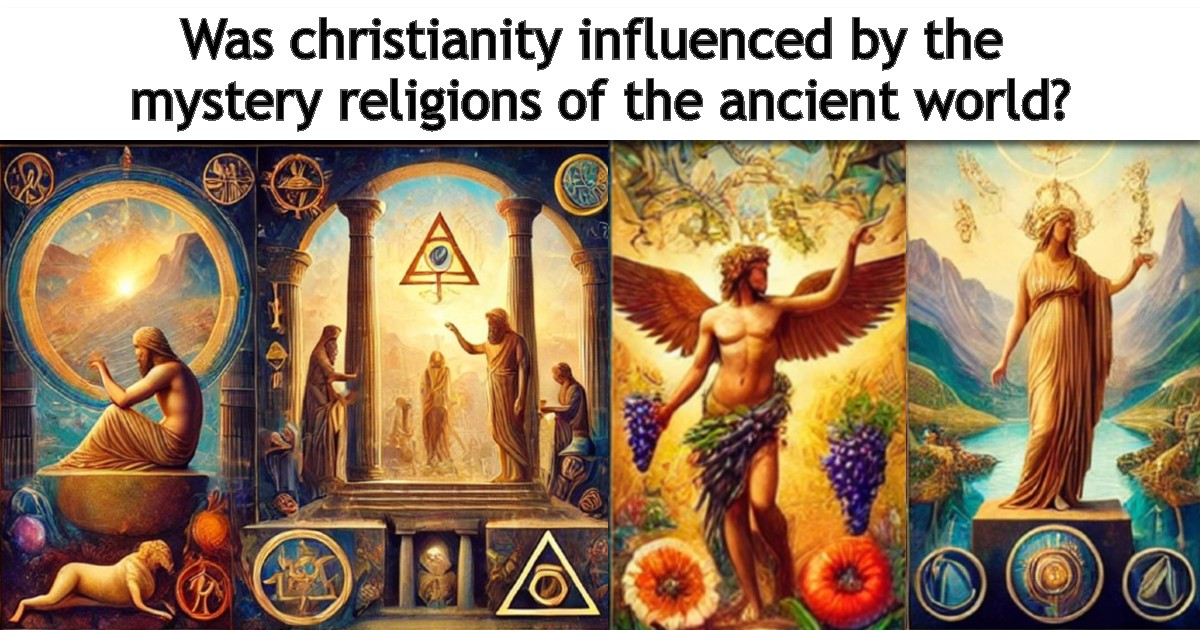Did Christianity invent its revolutionary ideas about resurrection, salvation, and atonement—or were these borrowed from the mystery religions of the ancient world?
The image of a divine savior who dies, offers salvation through his blood, and grants eternal life is not unique to Christianity. Throughout the Greco-Roman world of the 1st century CE, mystery cults flourished, each promising their initiates sacred knowledge, purification, and even immortality. Astonishingly, many of these cults contained elements eerily similar to Christian beliefs—ritual meals, sacrificial blood, divine rebirth, and the promise of salvation.
Could it be that Christianity, far from being a unique divine revelation, was simply the latest iteration of an ancient religious pattern?
Dying and Rising Gods Before Jesus
Throughout the ancient Mediterranean, gods who died and returned in some form were central to religious devotion. Some of the most shocking parallels to Christianity include:
- Osiris (Egyptian Mystery Cults): The story of Osiris, one of the oldest religious myths, tells of a god who is killed, dismembered, and resurrected by his wife Isis. His blood grants life, and through his death, his followers are offered a path to immortality. This was not just a metaphor—initiates into the Isis-Osiris cult participated in sacred rites where they believed they shared in Osiris’ resurrection. The connection to Christian ideas of atonement and life through divine sacrifice is impossible to ignore.
- Dionysus (Greek Mystery Cults): The Orphic traditions tell of Dionysus Zagreus, who was torn apart by the Titans, only to be reborn. His followers reenacted his death and resurrection through ritual feasts, consuming wine believed to be his blood. Sound familiar? The Eucharist, or Holy Communion, where Christians drink wine symbolizing the blood of Christ, is strikingly reminiscent of these ancient Dionysian rites.
- Attis (Phrygian Mystery Cults): Attis, a Phrygian god, was a divine son sacrificed on a tree, whose blood was believed to bring salvation. His worshipers engaged in ecstatic mourning rituals during which they identified with his suffering, followed by a triumphant celebration of his return to life. Attis’ mythology predates Jesus by centuries, yet his passion, death, and resurrection bear uncanny similarities to the Christian Passion narrative.
- Mithras (Roman Mithraism): The Roman mystery cult of Mithras, widely practiced by soldiers, included rituals that promised salvation through the god’s sacrifice. Mithraic initiates took part in a sacred communal meal, similar to the Christian Eucharist, and were “born again” through initiation rites. Mithras himself was often depicted slaughtering a sacred bull, its blood granting new life—a concept echoed in Christian theology about Christ’s blood washing away sin.
Were These Cults Practiced in the 1st-Century Greco-Roman World?
Yes. These were not obscure, forgotten cults—they were thriving across the empire at the exact same time Christianity emerged.
- The Cult of Isis and Osiris had spread from Egypt throughout the Roman Empire, with temples in Rome, Corinth, Ephesus, and even Jerusalem.
- Dionysian Mysteries were well-established throughout Greece, Italy, and Asia Minor, with initiates participating in secret feasts and rituals of divine communion.
- Mithraism was rapidly expanding among Roman soldiers, with underground sanctuaries (mithraea) found across the empire.
- The Cult of Attis and Cybele held annual public celebrations in Rome where worshipers ritually mourned Attis’ death and celebrated his resurrection.
Even in Jewish lands, Hellenistic influences had seeped in through Roman occupation. Cities like Caesarea Maritima and Scythopolis housed temples to Greco-Roman deities, and mystery cults flourished in neighboring regions. The idea that early Christians were unaware of or uninfluenced by these traditions is simply not credible.
Staggering Parallels Between Christianity and Pagan Mystery Cults
Christianity, far from being an outlier, fits into an ancient tradition of savior cults that shared the following stunning similarities:
Sacrificial Blood Brings Salvation
- Osiris’ blood granted life to his followers.
- Mithras’ bull’s blood offered renewal.
- Attis’ blood was celebrated in sacred rites.
- Jesus’ blood was said to redeem mankind.
Ritual Meals and Sacred Communion
- Dionysus’ followers drank wine symbolizing his blood.
- Mithraic initiates shared a sacred meal.
- The Isis cult held ritual feasts for divine unity.
- Early Christians drank Christ’s symbolic blood in the Eucharist.
Dying and Rising for Mankind’s Benefit
- Osiris: murdered and resurrected as lord of the afterlife.
- Dionysus: torn apart and reborn to bring salvation.
- Attis: sacrificed and returned to life.
- Jesus: crucified and resurrected to offer eternal life.
- Initiation and Rebirth into a New Life
- Mithraic initiates underwent baptism-like purifications.
- Osiris cultists were “born again” through sacred rites.
- Christians adopted baptism as the path to salvation.
Conclusion
Christianity did not emerge in a vacuum. It was born in a world already teeming with savior gods, sacrificial blood, and divine resurrection. Whether by deliberate adoption or cultural osmosis, it followed an ancient and widespread pattern—one that had captivated human imagination for centuries.
Was Jesus truly unique, or simply the latest version of an ancient myth? The answer may be more unsettling than most believers care to admit.
Sources
- Frazer, James. The Golden Bough, 1890.
- Carrier, Richard. On the Historicity of Jesus, 2014.
- Smith, Jonathan Z. Drudgery Divine, 1987.
- Ehrman, Bart. Did Jesus Exist?, 2012.
- Plutarch. On Isis and Osiris, Loeb Classical Library, 1936.
- The Derveni Papyrus, c. 340 BCE.
- The Mithras Liturgy, 4th century CE.

